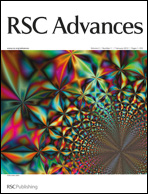Dansyl derivative functionalized Fe3O4@SiO2 fluorescent probe for detection and removal of Hg2+ in aqueous solution†
Abstract
In the present work, a novel dansyl group functionalized Fe3O4@SiO2 magnetic nanomaterial with a core–shell structure was developed, aiming to detect and remove Hg2+ from aqueous media. The multifunctional nanocomposite shows excellent fluorescence sensitivity and selectivity towards Hg2+ over other metal ions (Na+, K+, Mg2+, Al3+, Ca2+, Cd2+, Ni2+, Co2+, Fe3+, Zn2+, Pb2+, Cu2+, Ag+). Concentrations as low as 10−8 M can be detected and the addition of other metal ions has a negligible influence on the fluorescence emission. Regarding the reversibility of the nanosized sensor, the fluorescence of the DAP-Fe3O4@SiO2 nanocomposite in the presence of Hg2+ ions is found to be almost reversible when treated with iodide anion. Additionally, the nanocomposite can be easily separated from solutions by adding an external magnetic field. Moreover, the functionalized nanosphere shows a good adsorption capacity to Hg2+, which makes it repeatedly applicable for simultaneous Hg2+ sensing and removal from polluted water. These results indicate that the multifunctional nanocomposite may find potential applications for simple detection and easy removal of Hg2+ in biological and environmental areas.


 Please wait while we load your content...
Please wait while we load your content...